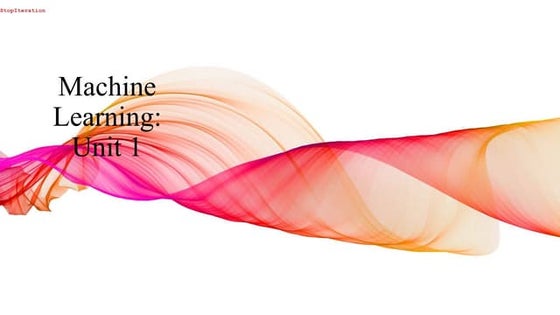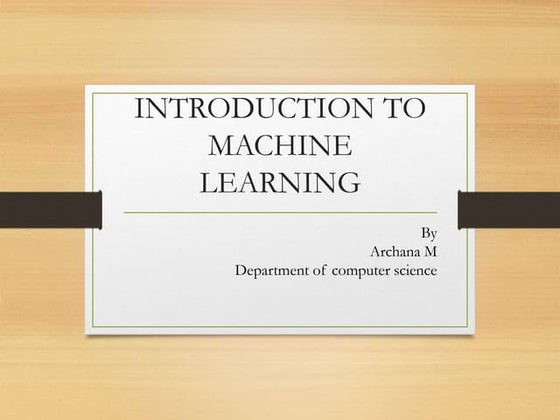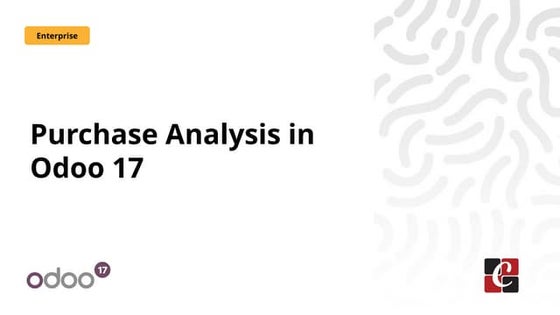Machine-Learning-Overview a statistical approach
- 2. Machine Learning ŌŚÅ Before we jump into Neural Networks, Tensorflow, Keras API etcŌĆ” its a good idea to understand a few fundamental ideas regarding machine learning. ŌŚÅ In this section weŌĆÖll cover some important theory and concepts surrounding machine learning.
- 3. Machine Learning ŌŚÅ Section Overview: ŌŚŗ What is Machine Learning? ŌŚŗ What is Deep Learning? ŌŚŗ Difference between Supervised and Unsupervised Learning ŌŚŗ Supervised Learning Process ŌŚŗ Evaluating performance ŌŚŗ Overfitting
- 4. What is Machine Learning? ŌŚÅ Machine learning is a method of data analysis that automates analytical model building. ŌŚÅ Using algorithms that iteratively learn from data, machine learning allows computers to find hidden insights without being explicitly programmed where to look.
- 5. What is it used for? ŌŚÅ Fraud detection. ŌŚÅ Web search results. ŌŚÅ Real-time ads on web pages ŌŚÅ Credit scoring. ŌŚÅ Prediction of equipment failures. ŌŚÅ New pricing models. ŌŚÅ Network intrusion detection. ŌŚÅ Recommendation Engines ŌŚÅ Customer Segmentation ŌŚÅ Text Sentiment Analysis ŌŚÅ Customer Churn ŌŚÅ Pattern and image recognition. ŌŚÅ Email spam filtering.
- 6. What are Neural Networks? ŌŚÅ Neural Networks are a way of modeling biological neuron systems mathematically. ŌŚÅ These networks can then be used to solve tasks that many other types of algorithms can not (e.g. image classification) ŌŚÅ Deep Learning simply refers to neural networks with more than one hidden layer.
- 7. Machine Learning ŌŚÅ There are different types of machine learning we will focus on during the next sections of the course: ŌŚŗ Supervised Learning ŌŚŗ Unsupervised Learning
- 8. Machine Learning ŌŚÅ Machine Learning ŌŚŗ Automated analytical models. ŌŚÅ Neural Networks ŌŚŗ A type of machine learning architecture modeled after biological neurons. ŌŚÅ Deep Learning ŌŚŗ A neural network with more than one hidden layer.
- 9. Machine Learning ŌŚÅ LetŌĆÖs begin by learning about one of the most common machine learning tasks- Supervised Learning!
- 11. Supervised Learning ŌŚÅ Supervised learning algorithms are trained using labeled examples, such as an input where the desired output is known. ŌŚÅ For example, a segment of text could have a category label, such as: ŌŚŗ Spam vs. Legitimate Email ŌŚŗ Positive vs. Negative Movie Review
- 12. Supervised Learning ŌŚÅ The network receives a set of inputs along with the corresponding correct outputs, and the algorithm learns by comparing its actual output with correct outputs to find errors. ŌŚÅ It then modifies the model accordingly.
- 13. Supervised Learning ŌŚÅ Supervised learning is commonly used in applications where historical data predicts likely future events.
- 14. Machine Learning Process Data Acquisition Data Cleaning Test Data Model Training & Building Model Testing Model Deployment
- 15. Machine Learning Process Data Acquisition ŌŚÅ Get your data! Customers, Sensors, etc...
- 16. Machine Learning Process Data Acquisition Data Cleaning ŌŚÅ Clean and format your data (using Pandas)
- 19. Machine Learning Process Data Acquisition Data Cleaning Test Data Model Training & Building Model Testing
- 20. Machine Learning Process Data Acquisition Data Cleaning Test Data Model Training & Building Model Testing Adjust Model Parameters
- 21. Machine Learning Process Data Acquisition Data Cleaning Test Data Model Training & Building Model Testing Model Deployment
- 22. Supervised Learning ŌŚÅ What we just showed is a simplified approach to supervised learning, it contains an issue! ŌŚÅ Is it fair to use our single split of the data to evaluate our models performance? ŌŚÅ After all, we were given the chance to update the model parameters again and again.
- 23. Supervised Learning ŌŚÅ To fix this issue, data is often split into 3 sets ŌŚŗ Training Data Ō¢Ā Used to train model parameters ŌŚŗ Validation Data Ō¢Ā Used to determine what model hyperparameters to adjust ŌŚŗ Test Data Ō¢Ā Used to get some final performance metric
- 24. Supervised Learning ŌŚÅ This means after we see the results on the final test set we donŌĆÖt get to go back and adjust any model parameters! ŌŚÅ This final measure is what we label the true performance of the model to be.
- 25. Supervised Learning ŌŚÅ In this course, in general we will simplify our data by using a simple train/test split. ŌŚÅ We will simply train and then evaluate on a test set (leaving the option to students to go back and adjust parameters). ŌŚÅ After going through the course, you will be able to easily perform another split to get 3 data sets if you desire.
- 27. Machine Learning ŌŚÅ Now that we understand the full process for supervised learning, letŌĆÖs touch upon the important topics of overfitting and underfitting.
- 28. Machine Learning ŌŚÅ Overfitting ŌŚŗ The model fits too much to the noise from the data. ŌŚŗ This often results in low error on training sets but high error on test/validation sets.
- 35. Machine Learning ŌŚÅ Underfitting ŌŚŗ Model does not capture the underlying trend of the data and does not fit the data well enough. ŌŚŗ Low variance but high bias. ŌŚŗ Underfitting is often a result of an excessively simple model.
- 38. Machine Learning ŌŚÅ This data was easy to visualize, but how can we see underfitting and overfitting when dealing with multi dimensional data sets? ŌŚÅ First letŌĆÖs imagine we trained a model and then measured its error over training time.
- 39. Machine Learning ŌŚÅ Good Model Error Training Time
- 40. Machine Learning ŌŚÅ Good Model Error Epochs
- 41. Machine Learning ŌŚÅ Bad Model Error Epochs
- 42. Machine Learning ŌŚÅ When thinking about overfitting and underfitting we want to keep in mind the relationship of model performance on the training set versus the test/validation set.
- 43. Machine Learning ŌŚÅ LetŌĆÖs imagine we split our data into a training set and a test set
- 44. Machine Learning ŌŚÅ We first see performance on the training set Epochs Error
- 45. Machine Learning ŌŚÅ Next we check performance on the test set Epochs Error
- 46. Machine Learning ŌŚÅ Ideally the model would perform well on both, with similar behavior. Epochs Error
- 47. Machine Learning ŌŚÅ But what happens if we overfit on the training data? That means we would perform poorly on new test data! Epochs Error
- 48. Machine Learning ŌŚÅ But what happens if we overfit on the training data? That means we would perform poorly on new test data! Epochs Error
- 49. Machine Learning ŌŚÅ This is a good indication of training too much on the training data, you should look for the point to cut off training time! Epochs Error
- 50. Machine Learning ŌŚÅ WeŌĆÖll check on this idea again when we actually begin creating models! ŌŚÅ For now just be aware of this possible issue!
- 52. Model Evaluation ŌŚÅ We just learned that after our machine learning process is complete, we will use performance metrics to evaluate how our model did. ŌŚÅ LetŌĆÖs discuss classification metrics in more detail!
- 53. Model Evaluation ŌŚÅ The key classification metrics we need to understand are: ŌŚŗ Accuracy ŌŚŗ Recall ŌŚŗ Precision ŌŚŗ F1 -Score
- 54. Model Evaluation ŌŚÅ But first, we should understand the reasoning behind these metrics and how they will actually work in the real world!
- 55. Model Evaluation ŌŚÅ Typically in any classification task your model can only achieve two results: ŌŚŗ Either your model was correct in its prediction. ŌŚŗ Or your model was incorrect in its prediction.
- 56. Model Evaluation ŌŚÅ Fortunately incorrect vs correct expands to situations where you have multiple classes. ŌŚÅ For the purposes of explaining the metrics, letŌĆÖs imagine a binary classification situation, where we only have two available classes.
- 57. Model Evaluation ŌŚÅ In our example, we will attempt to predict if an image is a dog or a cat. ŌŚÅ Since this is supervised learning, we will first fit/train a model on training data, then test the model on testing data. ŌŚÅ Once we have the modelŌĆÖs predictions from the X_test data, we compare it to the true y values (the correct labels).
- 59. Model Evaluation Test Image from X_test TRAINED MODEL
- 60. Model Evaluation Test Image from X_test Correct Label from y_test DOG TRAINED MODEL
- 61. Model Evaluation Test Image from X_test Correct Label from y_test DOG TRAINED MODEL DOG Prediction on Test Image
- 62. Model Evaluation Test Image from X_test Correct Label from y_test DOG TRAINED MODEL DOG Prediction on Test Image DOG == DOG ? Compare Prediction to Correct Label
- 63. Model Evaluation Test Image from X_test Correct Label from y_test DOG TRAINED MODEL CAT Prediction on Test Image DOG == CAT ? Compare Prediction to Correct Label
- 64. Model Evaluation ŌŚÅ We repeat this process for all the images in our X test data. ŌŚÅ At the end we will have a count of correct matches and a count of incorrect matches. ŌŚÅ The key realization we need to make, is that in the real world, not all incorrect or correct matches hold equal value!
- 65. Model Evaluation ŌŚÅ Also in the real world, a single metric wonŌĆÖt tell the complete story! ŌŚÅ To understand all of this, letŌĆÖs bring back the 4 metrics we mentioned and see how they are calculated. ŌŚÅ We could organize our predicted values compared to the real values in a confusion matrix.
- 66. Model Evaluation ŌŚÅ Accuracy ŌŚŗ Accuracy in classification problems is the number of correct predictions made by the model divided by the total number of predictions.
- 67. Model Evaluation ŌŚÅ Accuracy ŌŚŗ For example, if the X_test set was 1 00 images and our model correctly predicted 80 images, then we have 80/1 00. ŌŚŗ 0.8 or 80% accuracy.
- 68. Model Evaluation ŌŚÅ Accuracy ŌŚŗ Accuracy is useful when target classes are well balanced ŌŚŗ In our example, we would have roughly the same amount of cat images as we have dog images.
- 69. Model Evaluation ŌŚÅ Accuracy ŌŚŗ Accuracy is not a good choice with unbalanced classes! ŌŚŗ Imagine we had 99 images of dogs and 1 image of a cat. ŌŚŗ If our model was simply a line that always predicted dog we would get 99% accuracy!
- 70. Model Evaluation ŌŚÅ Accuracy ŌŚŗ Imagine we had 99 images of dogs and 1 image of a cat. ŌŚŗ If our model was simply a line that always predicted dog we would get 99% accuracy! ŌŚŗ In this situation weŌĆÖll want to understand recall and precision
- 71. Model Evaluation ŌŚÅ Recall ŌŚŗ Ability of a model to find all the relevant cases within a dataset. ŌŚŗ The precise definition of recall is the number of true positives divided by the number of true positives plus the number of false negatives.
- 72. Model Evaluation ŌŚÅ Precision ŌŚŗ Ability of a classification model to identify only the relevant data points. ŌŚŗ Precision is defined as the number of true positives divided by the number of true positives plus the number of false positives.
- 73. Model Evaluation ŌŚÅ Recall and Precision ŌŚŗ Often you have a trade-off between Recall and Precision. ŌŚŗ While recall expresses the ability to find all relevant instances in a dataset, precision expresses the proportion of the data points our model says was relevant actually were relevant.
- 74. Model Evaluation ŌŚÅ F1 -Score ŌŚŗ In cases where we want to find an optimal blend of precision and recall we can combine the two metrics using what is called the F1 score.
- 75. Model Evaluation ŌŚÅ F1 -Score ŌŚŗ The F1 score is the harmonic mean of precision and recall taking both metrics into account in the following equation:
- 76. Model Evaluation ŌŚÅ F1 -Score ŌŚŗ We use the harmonic mean instead of a simple average because it punishes extreme values. ŌŚŗ A classifier with a precision of 1 .0 and a recall of 0.0 has a simple average of 0.5 but an F1 score of 0.
- 77. Model Evaluation ŌŚÅ We can also view all correctly classified versus incorrectly classified images in the form of a confusion matrix.
- 80. Math & Statistics Domain Knowledge Machine Learning Software Research DS Model Evaluation ŌŚÅ The main point to remember with the confusion matrix and the various calculated metrics is that they are all fundamentally ways of comparing the predicted values versus the true values. ŌŚÅ What constitutes ŌĆ£goodŌĆØ metrics, will really depend on the specific situation!
- 81. Math & Statistics Domain Knowledge Machine Learning Software Research DS Model Evaluation ŌŚÅ Still confused on the confusion matrix? ŌŚÅ No problem! Check out the Wikipedia page for it, it has a really good diagram with all the formulas for all the metrics. ŌŚÅ Throughout the training, weŌĆÖll usually just print out metrics (e.g. accuracy).
- 82. Math & Statistics Domain Knowledge Machine Learning Software Research DS Model Evaluation ŌŚÅ LetŌĆÖs think back on this idea of: ŌŚŗ What is a good enough accuracy? ŌŚÅ This all depends on the context of the situation! ŌŚÅ Did you create a model to predict presence of a disease? ŌŚÅ Is the disease presence well balanced in the general population? (Probably not!)
- 83. Math & Statistics Domain Knowledge Machine Learning Software Research DS Model Evaluation ŌŚÅ Often models are used as quick diagnostic tests to have before having a more invasive test (e.g. getting urine test before getting a biopsy) ŌŚÅ We also need to consider what is at stake!
- 84. Math & Statistics Domain Knowledge Machine Learning Software Research DS Model Evaluation ŌŚÅ Often we have a precision/recall trade off, We need to decide if the model will should focus on fixing False Positives vs. False Negatives. ŌŚÅ In disease diagnosis, it is probably better to go in the direction of False positives, so we make sure we correctly classify as many cases of disease as possible!
- 85. Math & Statistics Domain Knowledge Machine Learning Software Research DS Model Evaluation ŌŚÅ All of this is to say, machine learning is not performed in a ŌĆ£vacuumŌĆØ, but instead a collaborative process where we should consult with experts in the domain (e.g. medical doctors)
- 87. Evaluating Regression ŌŚÅ LetŌĆÖs take a moment now to discuss evaluating Regression Models ŌŚÅ Regression is a task when a model attempts to predict continuous values (unlike categorical values, which is classification)
- 88. Evaluating Regression ŌŚÅ You may have heard of some evaluation metrics like accuracy or recall. ŌŚÅ These sort of metrics arenŌĆÖt useful for regression problems, we need metrics designed for continuous values!
- 89. Evaluating Regression ŌŚÅ For example, attempting to predict the price of a house given its features is a regression task. ŌŚÅ Attempting to predict the country a house is in given its features would be a classification task.
- 90. Evaluating Regression ŌŚÅ LetŌĆÖs discuss some of the most common evaluation metrics for regression: ŌŚŗ Mean Absolute Error ŌŚŗ Mean Squared Error ŌŚŗ Root Mean Square Error
- 91. Evaluating Regression ŌŚÅ Mean Absolute Error (MAE) ŌŚŗ This is the mean of the absolute value of errors. ŌŚŗ Easy to understand
- 92. Evaluating Regression ŌŚÅ MAE wonŌĆÖt punish large errors however.
- 93. Evaluating Regression ŌŚÅ MAE wonŌĆÖt punish large errors however.
- 94. Evaluating Regression ŌŚÅ We want our error metrics to account for these!
- 95. Evaluating Regression ŌŚÅ Mean Squared Error (MSE) ŌŚŗ This is the mean of the squared errors. ŌŚŗ Larger errors are noted more than with MAE, making MSE more popular.
- 96. Evaluating Regression ŌŚÅ Root Mean Square Error (RMSE) ŌŚŗ This is the root of the mean of the squared errors. ŌŚŗ Most popular (has same units as y)
- 97. Machine Learning ŌŚÅ Most common question from students: ŌŚŗ ŌĆ£Is this value of RMSE good?ŌĆØ ŌŚÅ Context is everything! ŌŚÅ A RMSE of $1 0 is fantastic for predicting the price of a house, but horrible for predicting the price of a candy bar!
- 98. Machine Learning ŌŚÅ Compare your error metric to the average value of the label in your data set to try to get an intuition of its overall performance. ŌŚÅ Domain knowledge also plays an important role here!
- 99. Machine Learning ŌŚÅ Context of importance is also necessary to consider. ŌŚÅ We may create a model to predict how much medication to give, in which case small fluctuations in RMSE may actually be very significant.
- 100. Evaluating Regression ŌŚÅ You should now feel comfortable with the various methods of evaluating a regression task.
- 102. Machine Learning ŌŚÅ WeŌĆÖve covered supervised learning, where the label was known due to historical labeled data. ŌŚÅ But what happens when we donŌĆÖt have historical labels?
- 103. Machine Learning ŌŚÅ There are certain tasks that fall under unsupervised learning: ŌŚŗ Clustering ŌŚŗ Anomaly Detection ŌŚŗ Dimensionality Reduction
- 104. Machine Learning ŌŚÅ Clustering ŌŚŗ Grouping together unlabeled data points into categories/clusters ŌŚŗ Data points are assigned to a cluster based on similarity
- 105. Machine Learning ŌŚÅ Anomaly Detection ŌŚŗ Attempts to detect outliers in a dataset ŌŚŗ For example, fraudulent transactions on a credit card.
- 106. Machine Learning ŌŚÅ Dimensionality Reduction ŌŚŗ Data processing techniques that reduces the number of features in a data set, either for compression, or to better understand underlying trends within a data set.
- 107. Machine Learning ŌŚÅ Unsupervised Learning ŌŚŗ ItŌĆÖs important to note, these are situations where we donŌĆÖt have the correct answer for historical data! ŌŚŗ Which means evaluation is much harder and more nuanced!
- 108. Unsupervised Process Data Acquisition Data Cleaning Test Data Model Training & Building Transformation Model Deployment
- 109. Machine Learning ŌŚÅ Later on in the course, weŌĆÖll explore unsupervised learning processes with specialized neural network structures, such as autoencoders.





























































































































































